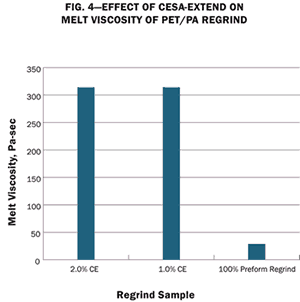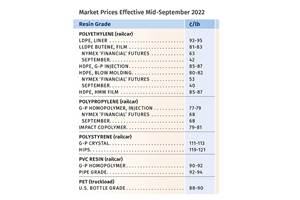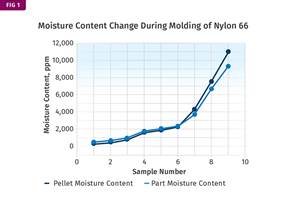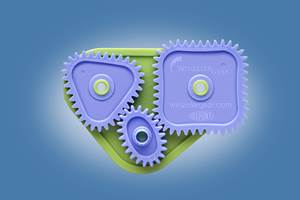'As Good as New' Chain Extender Restores Reclaimed Resins
A new additive can re-link polymer chains in reclaimed PET, nylon, and polycarbonate to revive degraded properties.
Condensation polymers like PET, nylon, and polycarbonate tend to degrade during processing. Degradation is caused by a loss of molecular weight, which leads to loss of important material properties, especially melt strength and processability. The result is that recycled and reclaimed resins of these types are often limited to applications that do not require high performance properties or, even worse, are rejected as unusable waste.
Although several technologies exist to reclaim degraded resins, there is a need for a simple, efficient, and low-cost technology that can reduce the loss of molecular weight and physical properties in reclaimed condensation polymers. Clariant’s “CESA-extend” chain extender (CE) is a new additive technology that offers just such a solution. This epoxy-functional styrene/acrylic oligomer, provided as a masterbatch in a variety of carrier resins, can be added to degraded condensation resins to re-link broken polymer chains in an extruder. Ideally, the polymer chains are re-linked in linear chain extensions, with minimal crosslinking—thus the term “chain extender” to describe this additive and its function.
During the extrusion process, CE has been shown to react with polymer end groups via step-growth kinetics, with minimum crosslinking or gel formation. It has strong reactivity with amine, anhydride, isocyanate, carboxyl, and hydroxyl end groups.
Four laboratory studies recently investigated the effect of this additive as a chain extender for various condensation polymers. Test data measured the value added to reclaimed condensation resins as indicated by four key characteristics: melt strength and processability, mechanical properties (Izod impact and tensile strength), hydrolytic stability, and clarity (light transmission).
Boost PET melt strength
A great concern in using recycled PET is its dramatically reduced melt strength, which makes it very difficult to process by extrusion. A practical measure of PET melt strength is its resistance to sag when extruded into a sheet or profile. Our first test compared the degree of sag in an extrudate from a recycled extrusion-grade PET with that of identical material extruded with CE masterbatch in four different letdowns: 0.25%, 0.5%, 1.0%, and 2.0%.
The test was run on a 27-mm twin-screw extruder, operating at a constant melt temperature and screw speed, with an 8-in. sheet die and downstream pick-up rolls. The rolls were aligned with the die lip and operated at a constant speed, with the first one positioned 6.25 in. from the die lip. Sag was calculated by subtracting the lowest point of the extrudate, relative to the floor, from the height of the die lip.
As the concentration of CE masterbatch was increased, the melt strength of the material increased, resulting in less sag or no sag at all in the case of 2% CE concentration (See photos and Fig. 1).
Add hydrolytic stability
Environmental moisture can cause hydrolysis and molecular-weight degradation in PC and PC/ABS alloys, even when in storage under normal conditions of humidity and temperature. Polar pigments such as TiO2 accelerate such degradation, so that just a few days of storage can measurably increase the melt-flow index of these alloys. The potential costs to processors of any hydrolytic degradation problems are likely to rise, because the trend is to require ever longer periods of hydrolytic stability and property retention in automotive, electrical, and electronic products made of these materials.
In this test, we measured whether varying levels of CE additive could reduce or compensate for the degradation occurring in a 70/30 PC/ABS blend during a seven-day accelerated test. The four PC/ABS samples tested included two untreated controls in pellet and extruded forms, and two samples containing 0.5% and 1.0% concentration of CE additive. All were exposed to 100% relative humidity at 95 C in a constant-humidity chamber for seven days. The MFI for each sample was measured daily.
Addition of CE additive dramatically reduced hydrolytic degradation of this polymer, enabling it to retain desirable MFI values far longer than control samples (Fig. 2). Both control samples show extensive degradation, as evidenced by a 65% increase in MFI. In contrast, there is a noticeable chain-extension effect in the CE-treated samples. Not only did they have lower MFI than the controls at the outset, but they also showed a slower rate of degradation throughout the test.
Use of 0.5% CE fully compensated for the degradation effects seen in the test, so that Day 7 MFI for the treated sample was equal to that of Day 0 for the control. The chain extension was even more significant at the 1% concentration, with this sample showing extremely high levels of hydrolytic stability and negligible degradation.
Upgrade PET/nylon regrind
Multilayer PET bottles with a barrier layer of aromatic nylon have been considered impossible to reprocess, due to the poor physical properties of the reground PET/nylon blend. Given the wide use of this barrier structure in packaging, the ability to reclaim and reuse it effectively would be a major step forward for plastics recycling.
Our third test evaluated the impact of the CE additive on the processability of reclaimed PET/nylon. Multilayer PET bottle preforms were ground and divided in three samples: a control and treated samples with 1% and 2% CE. Reprocessability of the samples were measured in terms of Izod impact (ASTM D256, Method A), melt viscosity (ASTM D3835), and tensile strength (ASTM D638).
Results show a dramatic improvement in properties of all CE-treated samples, with those containing 1% CE performing as well as or better than those with higher CE concentrations. Unnotched Izod impact of 1% CE-treated samples are 20% higher than the control samples and identical to the 2% CE samples (Fig. 3). The melt viscosity of 1% CE-treated samples is more than 11 times higher than that of the controls and identical to the 2% CE-treated samples (Fig. 4). Tensile strength of 1% CE-treated samples is 30% higher than the control samples and slightly above those of the 2% CE-treated samples (Fig. 5).
Retain PET clarity
The aim of the fourth study was to determine the effect of carrier resins (PE, PS, and PET) in CE masterbatches on the clarity and light transmission of reclaimed PET in the form of 20-mil extruded film. Reclaimed material was divided into four sample groups: untreated controls and samples treated with 0.5%, 1.0%, and 2.0% CE. All were evaluated for clarity and transmission characteristics in the 400 to 700 nm wavelength range of visible light.
As shown in Fig. 6, the 0.5% and 1.0% CE-treated samples showed no loss of clarity or light transmission with masterbatches having PS and PET carriers, while polyolefin carriers lowered light transmission at all addition levels. Some loss of clarity was seen in PET film samples containing 2% CE in a PET carrier.
Dr. Vahe Karayan joined Clariant Masterbatches in 1999 as technical manager for Additive Masterbatches. He has over 30 years of technical management experience in such fields as surface coatings, glass-reinforced thermosets, and color and additives for thermoplastics. He is co-author of a patent on chain-extender masterbatches. He can be reached by e-mail at vahe.karayan@clariant.com
Related Content
Volume Resin Prices Move in Different Directions
PE, PP, PVC, and ABS prices slump, while PS, PET, PC, and nylons 6 and 66 prices rise.
Read MorePrices of Volume Resins Drop
Price relief is expected to continue through the fourth quarter for nine major commodity and engineering resins, driven by widespread supply/demand imbalances.
Read MoreWhat's the Allowable Moisture Content in Nylons? It Depends: Part 2
Operating within guidelines from material suppliers can produce levels of polymer degradation. Get around it with better control over either the temperature of the melt or the barrel residence time.
Read MoreTracing the History of Polymeric Materials: Acetal
The road from discovery in the lab to commercial viability can be long, and this was certainly the case for acetal polymers.
Read MoreRead Next
Processor Turns to AI to Help Keep Machines Humming
At captive processor McConkey, a new generation of artificial intelligence models, highlighted by ChatGPT, is helping it wade through the shortage of skilled labor and keep its production lines churning out good parts.
Read MoreLead the Conversation, Change the Conversation
Coverage of single-use plastics can be both misleading and demoralizing. Here are 10 tips for changing the perception of the plastics industry at your company and in your community.
Read MoreWhy (and What) You Need to Dry
Other than polyolefins, almost every other polymer exhibits some level of polarity and therefore can absorb a certain amount of moisture from the atmosphere. Here’s a look at some of these materials, and what needs to be done to dry them.
Read More




































